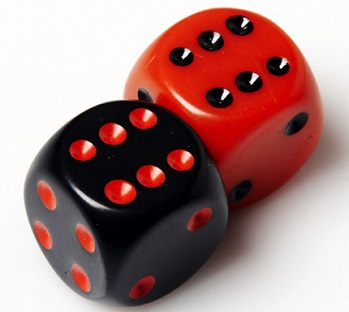

You have a not-small group of players. The game has a series of faceoffs, and the last two players standing win.
For a faceoff, one player known as the "attacker" is chosen randomly from among the surviving players. Then one player known as the "defender" is chosen randomly from among the surviving players. The attacker may choose one "out" player, who can not participate in the faceoff. One player can volunteer to be part of the attacking team, and one player can volunteer to be part of the defendng team. One of these "secondary" players is not officially part of the faceoff until he has touched the die.
So there are two to four players divided into two sides, attackers and defenders, with red dice and white dice respectively. All players involved in the faceoff roll at once, more or less.
The team that has the die with the highest number is safe. The player with the lowest number on the losing team is out of the game. If both teams get the highest number, it's a tie and nobody loses. If the losing side has two players with the same number, both players are out of the game.

Being chosen for faceoffs and what number is rolled is beyond your control; it's in the hands of capricious gods. What is within your control is the social shenanigans to increase your chances of surviving a faceoff.
Q: Why would someone volunteer to participate in a faceoff?
A: If Ralph decides to stand by Sally on the attacking team against a single
defender, the odds of the attacking team winning improve.
Ralph gets nothing from this; in fact it is dangerous for Ralph.
However, if Sally also does the same thing for Ralph, then Ralph and Sally do better
than if they both played alone.
Do you know who Jane's ally is? Note that people can be fair weather friends.
Let people mingle and eat Cheetos before the game starts.
This game could probably use an administrator to keep things on track.
You could use squares of paper with names on them to randomly draw
names for faceoffs.
Some numbers:
On average one player will lose the game per faceoff.
If you have twelve players and ten turns with choosing players, the out player,
nervous negotiations, and
dice rolls, you can imagine how long a game would be.
On average a player will be directly involved in only three faceoffs.
If you are an attacker, your odds of losing during a faceoff are (a = attacker,
d = defender):
57.9% for 1a2d
41.7% for 1a1d
24.3% for 2a2d
16.2% for 2a1d
llllllllll llllllllll llllllllll llllllllll llllllllll
llllllllll llllllllll llllllllll llllllllll llllllllll
llllllllll llllllllll llllllllll llllllllll llllllllll llllllllll llllllllll llllllllll llllllllll llllllllll
llllllllll llllllllll llllllllll llllllllll llllllllll llllllllll llllllllll llllllllll llllllllll llllllllll
llllllllll llllllllll llllllllll llllllllll llllllllll
llllllllll llllllllll llllllllll llllllllll llllllllll
Well that's nice. But when someone helps you, you are expected to reciprocate. Hence the blues.
The blue statistics for 2a2d and 2a1d are your odds of losing after participating in two faceoffs.
llllllllll llllllllll llllllllll llllllllll llllllllll
llllllllll llllllllll llllllllll llllllllll llllllllll
llllllllll llllllllll llllllllll llllllllll llllllllll
llllllllll llllllllll llllllllll llllllllll llllllllll
llllllllll llllllllll llllllllll llllllllll llllllllll llllllllll llllllllll llllllllll llllllllll llllllllll
llllllllll llllllllll llllllllll llllllllll llllllllll
llllllllll llllllllll llllllllll llllllllll llllllllll
llllllllll llllllllll llllllllll llllllllll llllllllll llllllllll llllllllll llllllllll llllllllll llllllllll
llllllllll llllllllll llllllllll llllllllll llllllllll
llllllllll llllllllll llllllllll llllllllll llllllllll
If there are 100 2a1d faceoffs, 32 attackers would lose and 58 defenders wouild lose.
If Michelle is the attacker against defender Brooke and her ally Taylor, Michelle has a 58% chance of losing the faceoff. Yikes. She gets Keith to be a second attacker. Her chance of losing drops to 16%, and Keith also has a whisker under one in six chance of losing.
Q: Wait a minute. Why did Taylor suddenly disappear when Keith joined the faceoff?
A: Well, at least in theory
1) Nervous Taylor could be intimidated by the numbers, so she declines the faceoff (i.e. she doesn't touch the die).
She will focus on preserving herself and also her closest
and most trustworthy ally Sally.
2) Taylor is allied with Brooke, but she also wants to work with
Keith. She is going to disappoint somebody.
3) Keith has sniffed out who Brooke's ally is. In addition to
participating in the faceoff Keith informs Michelle about this. Michelle
makes Taylor the out player, so Taylor can not participate in the faceoff.
Some cloak and dagger moves:
You can lie to people, use people. If it works it's good.
People could use carrot and stick ("Do what I say or else!").
John is the attacker, while your ally Rapunzel is the defender. If you participate in the faceoff you could die, while if you don't participate then Rapunzel might give up on working with you. What can you do? Well, if you can find a way to have John make you the out player without Rapunzel smelling a rat, you solved your problem.
You could make a secret, unexpected alliance.
You could make a fake alliance.
You make a show of allying with someone
to throw people off the scent, but you both agree it is not a real alliance.
Q: How many players is this for?
Short answer: a dozen
Long answer:
No more players than the ones you have available.
It depends on the minimum number of turns you will accept for a game.
The number of turns will be basically the number of players minus two.
There should be enough game that two players can repeatedly be involved in faceoffs together, so that they can assist each other reciprocally. A large number of turns will allow this. On the other hand, a small number of players means that two players are more likely to be roped into a given faceoff.
You could make Stand By Me and stuff it in a little Altoids tin. Get two red dice, two white dice, some squares or rectangles of paper, and a small pencil to write names. Cram it all in a rugged, portable Altoids tin.
By the way, I'm not so sure these games need instructions, awkward pieces of paper.
In the highly-connected 21st century world you can look up rules. In the village with
the dirt road they don't have written instructions either.